Excerpts from Jim Conrad's
Naturalist Newsletter
from the June 19, 2016 Newsletter issued from Hacienda Chichen Resort beside Chichén Itzá Ruins, central Yucatán MÉXICO
FALSE TAMARIND FLOWERING
Last year at this same time, on the northern Yucatan coast at Río Lagartos, I reported on flowering False Tamarind, Lysiloma latisiliquum {see next section}. Now it's also flowering here in the central Yucatan, but I'm noticing small differences between our trees and those on the coast. The ones here seem to be the more commonly encountered type. I want to post the following pictures to help others understand the variations, and maybe to set off a discussion about the non-standard type documented up at Río Lagartos.
The subdivisions of our Chichén Itzá tree's twice-compound leaves bear more pairs of leaflets than the Río Lagartos ones, as shown below:

The corollas of our False Tamarinds and others I see on the Internet are pinkish, while those at Río Lagartos were greenish white. Our pinkish ones are shown below:

False Tamarinds are very nearly acacias, and in the past were considered to be acacias. One feature that False Tamarinds have that acacias don't is very large, leafy stipules at the base of new leaf petioles -- these were also present on the Río Lagartos trees -- as shown below:

Atop leaf petioles, just like the Río Lagartos ones, our trees bear glands, possibly secreting compounds that attract ants that help defend the tree against herbivores. A gland is shown below:
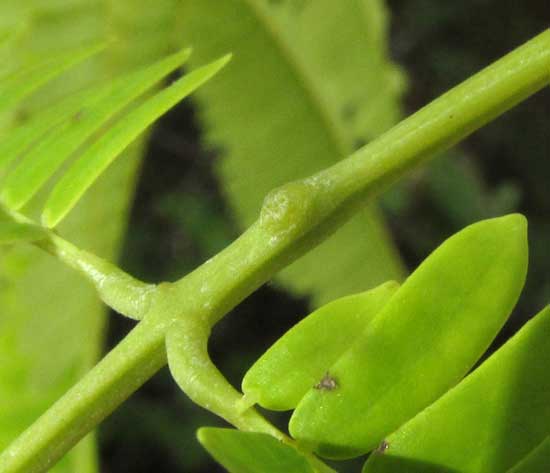
Beneath our Chichén Itzá tree lay many legumes from the last season, some shown below:

The Río Lagartos tree grew in very thin soil and was scrubby and low-lying, along with other stunted tree species that in thicker soil and where there's more rain make regular trees. Below, you can see the well formed trunk of our Chichén Itzá tree:
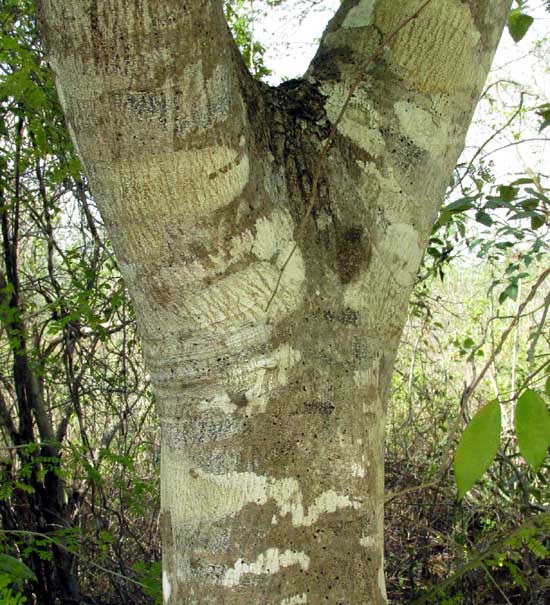
Down here even the most informed field workers are still struggling to figure out what's what in the natural world, so documentation like this really has some value for them.
Besides, for me at this point in my life, few things are more appealing than describing a tree.
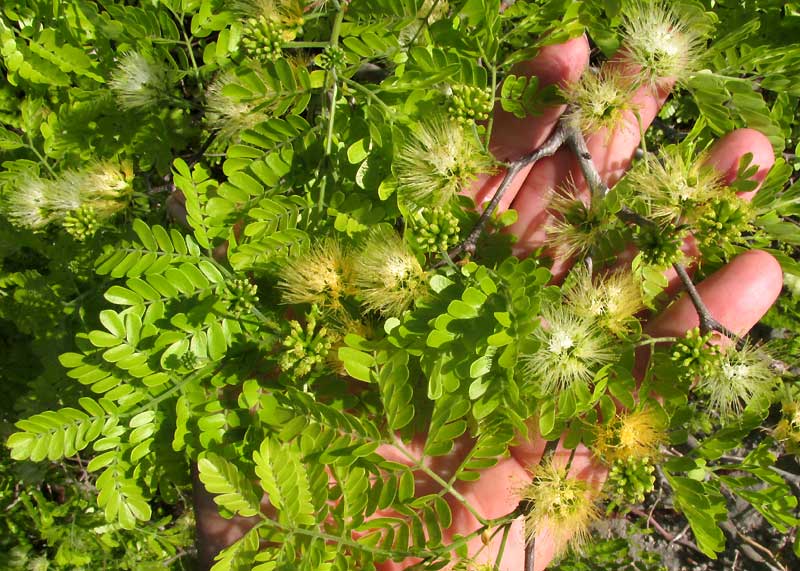
from the June 14, 2015 Newsletter issued from Río Lagartos, on the Yucatan Peninsula's northern coast (~N21.60°, ~W88.16°), Yucatán state, MÉXICO
FALSE TAMARIND FLOWERING
Nowadays False Tamarinds are flowering prodigiously, their white flower bunches very conspicuous, fragrant and bee-buzzed, as shown below:
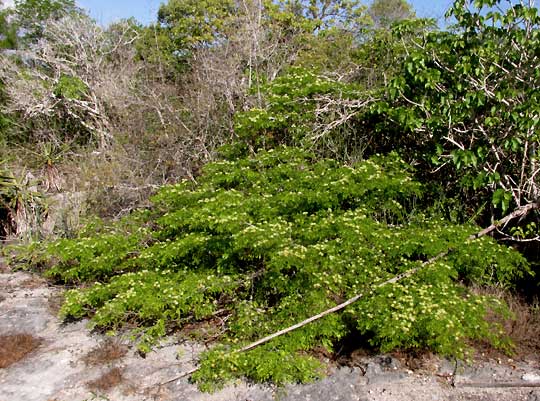
Normally the trees' branches mingle with branches of other trees and the tree's form is more or less treelike, but here you can see that when given a chance in our arid climate, instead of competing with neighbors for resources, it likes to sprawl into open areas.
At the top of this page you see a close-up of its flower bunches, which are pure white when they first develop but fade to yellowish after a day or so. A flowering head atop a slender stem, or stipe, suggestive of acacia flower heads, is shown below:
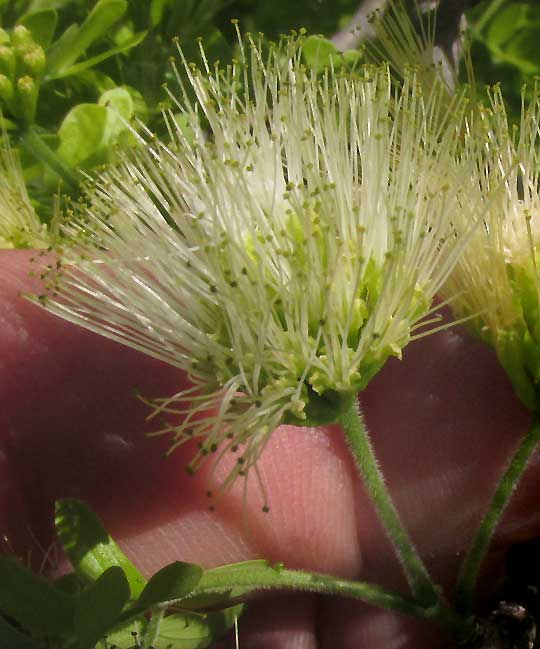
In fact, False Tamarind's flowers and leaves are so similar to those of acacias that I don't know why the two genera are separated, and some experts have wondered that, too. I understand that the main differences are technical features of the legume-type fruits. Another difference might be shown below:

That's a compound leaf's petiole shooting off toward the picture's top, right corner, with a single raised gland on it, rather like petioles of some of the ant-attracting acacia species. But notice the single, yellowish-green, fingernail-like stipule at the petiole's base, arranged horizontally at the picture's middle bottom. That's a bit unusual and not something I recall among the acacias.
Anyway, nowadays the False Tamarind's fresh, green leaves and fragrant, powder-puff clusters of flowers contribute to the landscape's springy feeling.
from the December 11, 2011 Newsletter issued from Hacienda Chichen Resort beside Chichén Itzá Ruins, central Yucatán, MÉXICO
TSALAM
Tsalam is LYSILOMA LATISILIQUUM, a member of the Bean Family. Though its feathery leaves look like those of numerous other acacia-like tree species found here, at this time of year Tsalam is easy to recognize because of its large, flat, legumes with enlarged edges along both sides and, most conspicuously, the odd manner by which the legumes' dark covering flakes off, making the pods look faded and abused, as shown below:
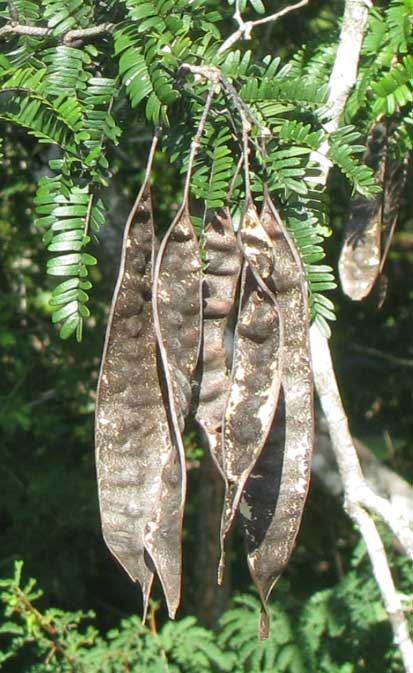
The Biblioteca Digital de la Medicina Tradicional Mexicana says that traditionally Tsalam's leaves have been roasted and pound into a powder to apply to sores and wounds. The tree also is used for asthma and coughs in general, but it's not said how.
On our own page written by my friend Louise in Mérida, about using natural dyes to color henequen fibers, Louise writes that Tzalam's "...bark or core wood gives a reddish brown tone. It is one of the dyes that will vary in intensity depending on the age of the tree or on the seasonal climatic conditions. The bark can be stored for a few days and still be effective. It is a natural mordant."
Louise's very interesting page with more info is at www.backyardnature.net/m/crafts/louise_v.htm.